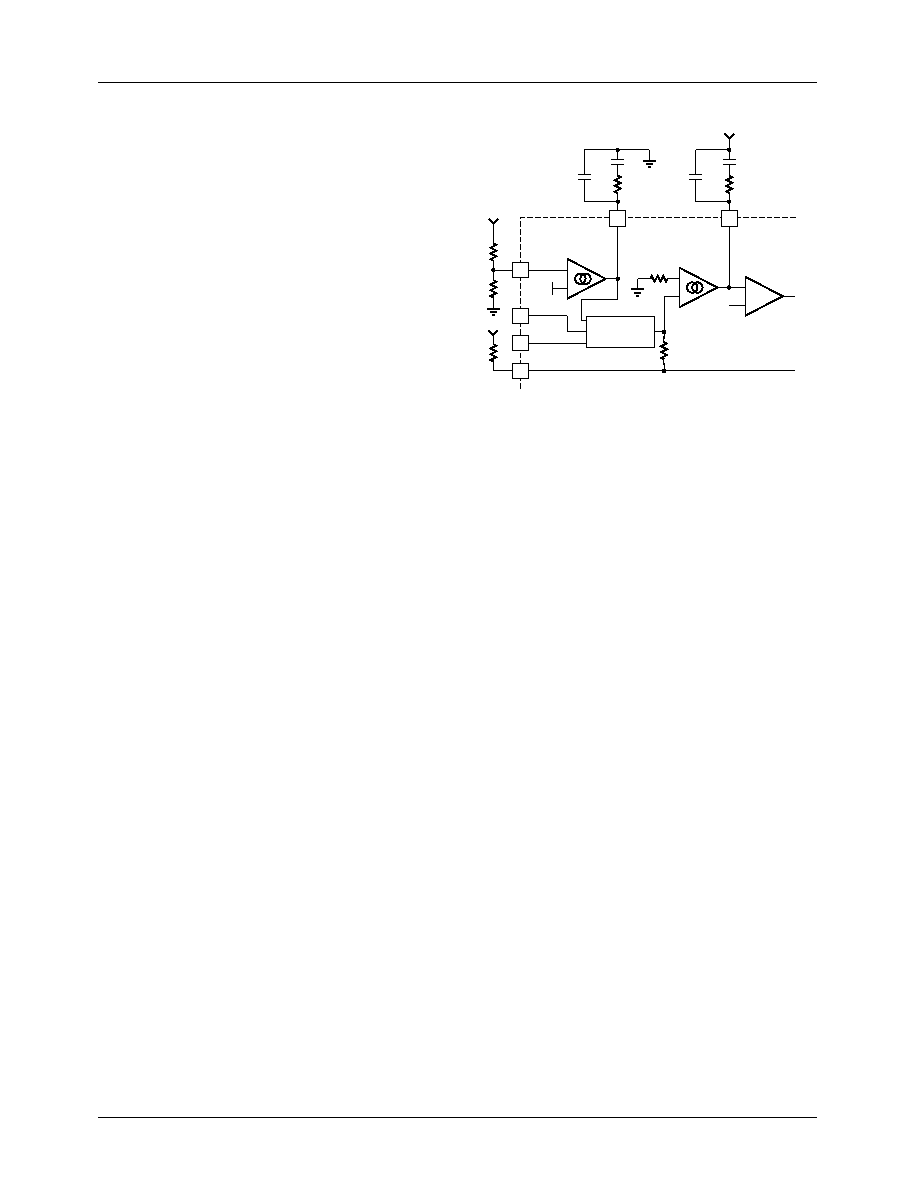- 您現(xiàn)在的位置:買賣IC網(wǎng) > PDF目錄224334 > ML4841CP (FAIRCHILD SEMICONDUCTOR CORP) Variable Feedforward PFC/PWM Controller Combo PDF資料下載
參數(shù)資料
| 型號(hào): | ML4841CP |
| 廠商: | FAIRCHILD SEMICONDUCTOR CORP |
| 元件分類: | 穩(wěn)壓器 |
| 英文描述: | Variable Feedforward PFC/PWM Controller Combo |
| 中文描述: | 0.5 A POWER FACTOR CONTROLLER WITH POST REGULATOR, PDIP16 |
| 封裝: | PLASTIC, DIP-16 |
| 文件頁(yè)數(shù): | 14/15頁(yè) |
| 文件大小: | 129K |
| 代理商: | ML4841CP |
第1頁(yè)第2頁(yè)第3頁(yè)第4頁(yè)第5頁(yè)第6頁(yè)第7頁(yè)第8頁(yè)第9頁(yè)第10頁(yè)第11頁(yè)第12頁(yè)第13頁(yè)當(dāng)前第14頁(yè)第15頁(yè)

ML4841
PRODUCT SPECIFICATION
8
REV. 1.0.3 6/13/01
The output of the gain modulator is a current signal, in
the form of a full wave rectied sinusoid at twice the line
frequency. This current is applied to the virtual-ground
(negative) input of the current error amplier. In this way the
gain modulator forms the reference for the current error
loop, and ultimately controls the instantaneous current draw
of the PFC from the power line. The general form for the
output of the gain modulator is:
More exactly, the output current of the gain modulator is
given by:
where K is in units of V-1.
Note that the output current of the gain modulator is limited
to
200A.
Current Error Amplier
The current error amplier’s output controls the PFC duty
cycle to keep the current through the boost inductor a linear
function of the line voltage. At the inverting input to the
current error amplier, the output current of the gain modu-
lator is summed with a current which results from a negative
voltage being impressed upon the ISENSE pin (current into
ISENSE
VSENSE/3.5k). The negative voltage on ISENSE
represents the sum of all currents owing in the PFC circuit,
and is typically derived from a current sense resistor in series
with the negative terminal of the input bridge rectier. In
higher power applications, two current transformers are
sometimes used, one to monitor the ID of the boost
MOSFET(s) and one to monitor the IF of the boost diode.
As stated above, the inverting input of the current error
amplier is a virtual ground. Given this fact, and the
arrangement of the duty cycle modulator polarities internal
to the PFC, an increase in positive current from the gain
modulator will cause the output stage to increase its duty
cycle until the voltage on ISENSE is adequately negative to
cancel this increased current. Similarly, if the gain modula-
tor’s output decreases, the output duty cycle will decrease, to
achieve a less negative voltage on the ISENSE pin.
There is a modest degree of gain contouring applied to the
transfer characteristic of the current error amplier, to
increase its speed of response to current-loop perturbations.
However, the boost inductor will usually be the dominant
factor in overall current loop response. Therefore, this
contouring is signicantly less marked than that of the
voltage error amplier. This is illustrated in the Typical
Performance Characteristics.
Figure 2. Compensation Network Connections for the
Voltage and Current Error Amplifiers
Cycle-By-Cycle Current Limiter
The ISENSE pin, as well as being a part of the current feed-
back loop, is a direct input to the cycle-by-cycle current
limiter for the PFC section. Should the input voltage at this
pin ever be more negative than -1V, the output of the PFC
will be disabled until the protection ip-op is reset by the
clock pulse at the start of the next PFC power cycle.
Overvoltage Protection
The OVP comparator serves to protect the power circuit
from being subjected to excessive voltages if the load should
suddenly change. A resistor divider from the high voltage
DC output of the PFC is fed to VFB. When the voltage on
VFB exceeds 2.7V, the PFC output driver is shut down.
The PWM section will continue to operate. The OVP
comparator has 125mV of hysteresis, and the PFC will not
restart until the voltage at VFB drops below 2.58V. The VFB
should be set at a level where the active and passive external
power components and the ML4841 are within their safe
operating voltages, but not so low as to interfere with the
boost voltage regulation loop.
Error Amplier Compensation
The PWM loading of the PFC can be modeled as a negative
resistor; an increase in input voltage to the PWM causes a
decrease in the input current. This response dictates the
proper compensation of the two transconductance error
ampliers. Figure 2 shows the types of compensation
networks most commonly used for the voltage and current
error ampliers, along with their respective return points.
The current loop compensation is returned to VREF to
produce a soft-start characteristic on the PFC: as the
reference voltage comes up from zero volts, it creates a
differentiated voltage on IEAO which prevents the PFC from
immediately demanding a full duty cycle on its boost
converter.
I
GAINMOD
I
AC
VEAO
×
V
RMS
2
--------------------------------
1V
×
I
GAINMOD
K
VEAO
1.5V
–
()
×
I
AC
×
(1)
15
VEAO
IEAO
VFB
IAC
VRMS
ISENSE
2.5V
-
+
16
2
4
3
VEA
-
+
IEA
+
-
VREF
1
PFC
OUTPUT
GAIN
MODULATOR
相關(guān)PDF資料 |
PDF描述 |
|---|---|
| ML6657-101D | 12000 MHz - 18000 MHz RF/MICROWAVE VARIABLE ATTENUATOR, 3 dB INSERTION LOSS-MAX |
| ML6657-102D | 12000 MHz - 18000 MHz RF/MICROWAVE VARIABLE ATTENUATOR, 3.4 dB INSERTION LOSS-MAX |
| ML776H8 | 1310 nm, LASER DIODE |
| ML9SM11-03-09 | 1533 nm, LASER DIODE |
| ML9SM22-03-15 | 1576 nm, LASER DIODE |
相關(guān)代理商/技術(shù)參數(shù) |
參數(shù)描述 |
|---|---|
| ML4841CP_Q | 功能描述:功率因數(shù)校正 IC PFC Controller PWM Combo RoHS:否 制造商:Fairchild Semiconductor 開關(guān)頻率:300 KHz 最大功率耗散: 最大工作溫度:+ 125 C 安裝風(fēng)格:SMD/SMT 封裝 / 箱體:SOIC-8 封裝:Reel |
| ML4841CS | 制造商:MICRO-LINEAR 制造商全稱:MICRO-LINEAR 功能描述:Variable Feedforward PFC/PWM Controller Combo |
| ML4841IP | 制造商:MICRO-LINEAR 制造商全稱:MICRO-LINEAR 功能描述:Variable Feedforward PFC/PWM Controller Combo |
| ML4841IS | 制造商:MICRO-LINEAR 制造商全稱:MICRO-LINEAR 功能描述:Variable Feedforward PFC/PWM Controller Combo |
| ML485 | 制造商:TRIQUINT 制造商全稱:TriQuint Semiconductor 功能描述:1.6-3.2 GHz High IP3 Mixer with Integrated LO Amp |
發(fā)布緊急采購(gòu),3分鐘左右您將得到回復(fù)。